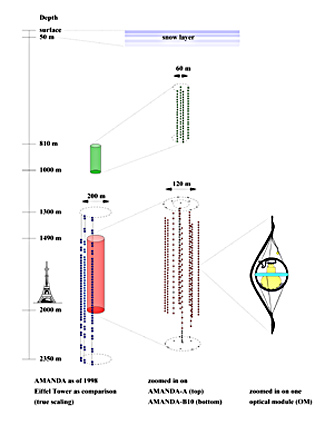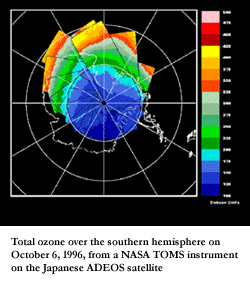The polar regions have been called Earth's window
to outer space. This term originally applied to study of aurora and
other phenomena related to interaction of solar plasmas and fields. In this context the polar upper
atmosphere is a screen on which the results of such interactions can
be viewed and through which other evidence of space physics processes
can pass. Today, this concept of Earth's polar atmosphere as a window
includes research in other fields as well. With discovery of polar stratospheric
ozone depletions, a window previously thought “closed” (the
ultraviolet window) is now known to “open” in certain seasons. In astronomy and astrophysics,
favorable atmospheric conditions and the unique location of the South
Pole enable scientists to use this window to probe the structure of
the Sun and the universe with unprecedented precision.
interaction of solar plasmas and fields. In this context the polar upper
atmosphere is a screen on which the results of such interactions can
be viewed and through which other evidence of space physics processes
can pass. Today, this concept of Earth's polar atmosphere as a window
includes research in other fields as well. With discovery of polar stratospheric
ozone depletions, a window previously thought “closed” (the
ultraviolet window) is now known to “open” in certain seasons. In astronomy and astrophysics,
favorable atmospheric conditions and the unique location of the South
Pole enable scientists to use this window to probe the structure of
the Sun and the universe with unprecedented precision.
The aeronomy and astrophysics program supports
studies of three regions:
- the stratosphere and the mesosphere. Current
research focuses on stratospheric chemistry and aerosols, particularly
in the context of the ozone hole. The polar stratosphere is expected
to be a field of continued interest and growth.
- the thermosphere, the ionosphere, and the
magnetosphere. These regions derive many of their characteristics
from the interplay of ionized plasmas and energetic charged particles
with geomagnetic and geoelectric fields. The upper atmosphere, particularly
the ionospheric portion of it, is the ultimate sink of solar wind
energy that is transported into the magnetosphere. Energy dissipates
in the ionosphere because of particle precipitation, which is the
result in part of resonant wave-particle interactions, and because
of the Joule heating that is a result of currents driven by electric
fields.
- astronomy and astrophysical studies of the
regions of the universe outside the magnetosphere, including solar
astronomy and cosmic ray physics. Astrophysical studies are primarily
conducted at the South Pole station or on long-duration balloon flights
launched from McMurdo.
 Major goals are to sponsor research that requires
or would benefit from the unique conditions of the Antarctic, to contribute
to understanding of the role of the Antarctic in global environmental
change, to participate in interdisciplinary studies of geosphere-biosphere
interactions in the middle and upper atmosphere, and to improve understanding
of the coupling of the Earth's polar atmosphere with the magnetosphere
and of the ways in which both are affected by solar activity.
Major goals are to sponsor research that requires
or would benefit from the unique conditions of the Antarctic, to contribute
to understanding of the role of the Antarctic in global environmental
change, to participate in interdisciplinary studies of geosphere-biosphere
interactions in the middle and upper atmosphere, and to improve understanding
of the coupling of the Earth's polar atmosphere with the magnetosphere
and of the ways in which both are affected by solar activity.
As an example of the unique conditions which
can be exploited for science, AMANDA, which is pictured above, uses photo detectors buried
over a kilometer deep in the ice sheet at south pole to detect high
energy neutrinos which can be used to image portions of the Universe
which are completely obscured to ordinary radiation.